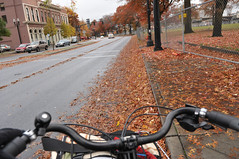
cleaning, you might want to
carry a broom.
(Photos © J. Maus/BikePortland)
The Portland Bureau of Transportation (PBOT) has unveiled a list of proposed cuts intended to slash their discretionary budget by $15-16 million. The unprecedented cuts — which amount to about 20% of $70 million in discretionary revenue — comes as PBOT grapples with how continue providing services while revenue sources have failed to keep pace with demands and commitments made in previous years are now coming due.
“When you’re cutting $15 million on an ongoing basis, you’re cutting into the muscle, that’s a fact.”
— Tom Miller, Director of PBOT
In a meeting on Tuesday, bureau director Tom Miller told us that, “The cuts are so big it’s truly bureau-wide” and that, after a decade of whittling down their budget to trim fat, these new cuts go into “the muscle of the organization.”
“What you’ll see here are some very painful cuts across the organization… If you self-identify as a motorist, or as a bicyclist, or as a transit user… Every mode, through the life-cycle of what we do to service that mode, you’ll see cuts across the realm.
When you’re cutting $15 million on an ongoing basis, you’re cutting into the muscle, that’s a fact.”
To decide how where and how deep to make the cuts, PBOT has worked with staff and with a Budget Advisory Committee made up of community stakeholders. In total, there are 63 “strategic reductions” in the proposed cuts. All of the bureau’s programs have been ranked and scored against four criteria: “Safety”, “Asset Management”, “Health/Livability”, and “Economic Vitality”.
As to how PBOT decided the proportion of cut a specific program would get, Miller said they used “professional judgment.”
The biggest reductions (and the ones that have garnered the most headlines) are to “street preservation” and re-paving projects. PBOT will completely suspend their large-scale re-paving projects on major arterials (saving $4.4 million a year) and they will reduce their pavement maintenance budget (which pays for things like crack-sealing) by $1 million (or 10% of the total).
While smooth streets are important for everyone, many of the cuts have an even more direct impact on bicycling and walking.
The Transportation Options Division (which promotes biking, walking and transit) will be slashed by $350,000 or about one-third of their total budget. Specifically, those cuts will include a reduction to the popular SmartTrips program from 25,000 to 19,000 households per year, a cut to Sunday Parkways events of $50,000 a year, reductions to the Safe Routes to School program budget (the service side, not the infrastructure side) and the elimination of several staff positions (one of which is already vacant and will not be filled).
While none of those cuts will spell doom for these important programs, they will certainly have an impact. City Traffic Engineer Rob Burchfield told me on Tuesday that, while most of the money for Sunday Parkways comes from private sponsors and donors, the $50,000 cut may make it harder for PBOT to raise money for the events. “That may be a challenge, because without some skin in the game [investment from the City], those outside vendors are less likely to say, ‘we’ll give you our money’ if it looks like the City isn’t committed to it.”
Another place that will feel the pinch is PBOT’s Neighborhood Greenway program. This program — which has been building out a citywide network of low-stress, family-friendly bike boulevards at a pace of 15 miles per year — will see a cut of $100,000, which is 10% of its $1 million per year budget.
Other cuts include a $50,000 reduction to PBOT’s $500,000 a year, “Ped & Bike Safety” fund and a reduction of the street cleaning budget by $550,000. That large cut is broken down into four line items: cleaning streets in the Central Business District (34% reduction), the Transit Mall (13% reduction), arterial streets (22% reduction) and “Clean Bike and Pedestrian Areas” will see a 38% reduction.
Bike racks will also suffer a bit. A line item listed as “Structures – Structural Maintenance” will get a $175,000 cut. PBOT says that reduction will come by reducing bike rack maintenance and construction. Burchfield explains that this cut doesn’t mean they’ll install fewer racks, but that existing racks won’t get the attention they used to. As an example, Burchfield said, “If somebody calls us up and says, ‘The bolts are loose on a bike rack, can you come out and fix it?’, our response to that would be diminished.”
Another reduction that caught my eye was a 75% reduction in “Traffic Operations – Special Events.” As part of their budget cuts and restructuring, PBOT wants to change their policy of providing traffic services at parades and other community events. In the past, PBOT would subsidize many large events with barricades, signage and other traffic operations expenses. Now, according to Burchfield, “PBOT will move from a subsidy to a cost recovery model.”
The new policy would require large events with paying participants — like Bridge Pedal, the Portland Triathlon, the Portland Marathon and so on — to pay for the City’s traffic operations help. The idea, says PBOT, is that these type of events can simply pass on the costs to their participants. An exception to this rule will be made for small, community parades and events that require services of $2,500 or less.
Many of the budget cuts are small reductions that shift PBOT’s policy for general maintenance and improvements to the transportation system from being proactive to being reactive. In other words attention and responsiveness to routine maintenance of bridges, signal timing, paving markings, street cleaning and so on would have longer intervals or would only be done if a hazard or a safety issue was reported.
One line item that should raise eyebrows of walking (and accessibility) advocates is over $1.4 million in cuts to PBOT’s various sidewalk programs. The largest cut would slash $1 million from PBOT’s budget for constructing ADA accessible sidewalk ramps. Sidewalks take another hit of $457,000 with PBOT cutting their sidewalk inspections and repairs budgets by 43% and 46% respectively.
In the end, Miller acknowledges that the elephant in the room is the dire need for a new revenue source. “At the end of the day, we need new money, new revenue,” he said. While he has lots of ideas on where new revenue could come from (his favorite is more innovative parking fees), Miller has been directed by Mayor Sam Adams to not consider any new revenue ideas at this time.
But Miller isn’t letting this budget crisis go without seizing it as an opportunity to revamp how PBOT does business. He says the process they’re undergoing is “more transparent and more intensive” than the agency has had in the past and he’s using it to develop a template for how the bureau provides services in the future (more on that to come).
The size, scope, and context of what’s going on here is a big deal. I hope everyone pays attention and stays tuned. For more details on the list of proposed cuts, delve into the PDFs below (the first is a list of the cuts and programs, the second is an explanation of the cuts):
– PBOT FY 12-13 Proposed Cuts Summary – DRAFT
– PBOT Program Rankings and Potential Cuts – DRAFT


